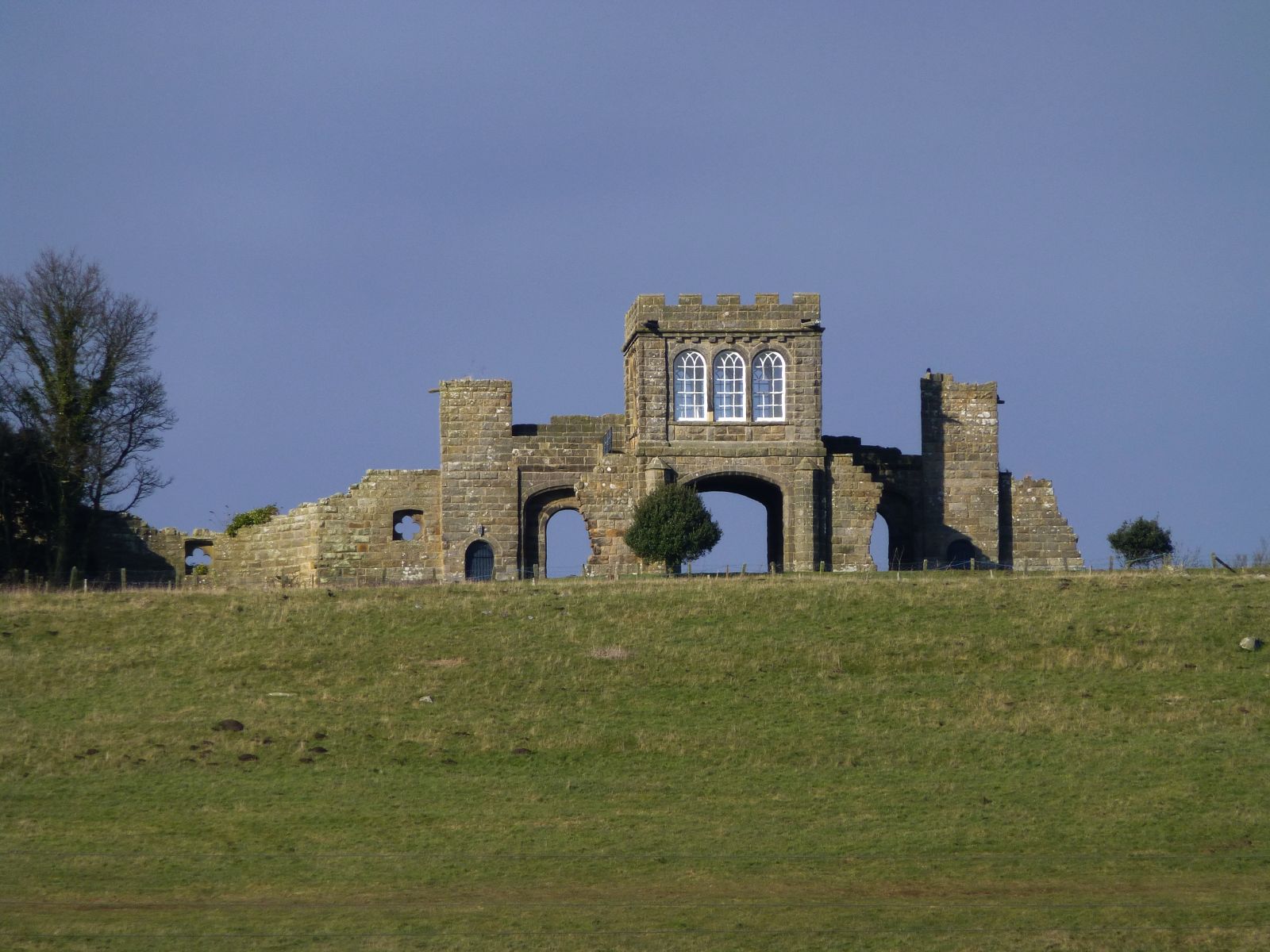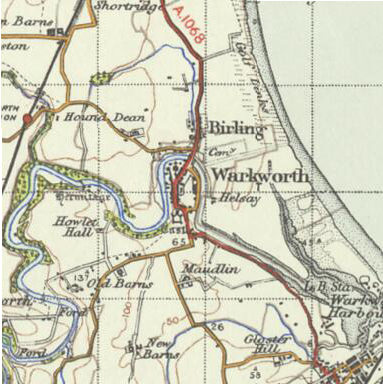|
Ratcheugh Observatory
Ratcheugh Observatory is a late 18th-century folly on a prominent crag between Alnwick and Longhoughton, Northumberland, Longhoughton in north Northumberland, England. Commissioned by Hugh Percy, 1st Duke of Northumberland, the castellated Observatory incorporates a viewing tower with prospects of Alnwick and its castle, and of the North Sea coast at Boulmer. Location Ratcheugh Observatory is located on Ratcheugh Crag, a local whinstone high-point above a foreground of fields at or lower elevations, situated east-north-east of Alnwick and west-south-west of Longhoughton; inland from the coast at Boulmer, in north Northumberland. Observatory The Observatory, a Listed building#Grade I, Grade 1 listed building, is a screen-wall built at the crag edge, incorporated into which are a number of turrets or towers; and having towards its northern extent a square-plan viewing tower built on open hollow-chamfered arches. The tower has a single enclosed room, each wall having three larg ... [...More Info...] [...Related Items...] OR: [Wikipedia] [Google] [Baidu] |
Hulne Priory
Hulne Priory, Hulne Friary or Hulne Abbey was a friary founded in 1240 by the Carmelites or 'Whitefriars'. It is said that the Northumberland site, quite close to Alnwick, was chosen for some slight resemblance to Mount Carmel where the order originated. Substantial ruins survive, watched over by the stone figures of friars carved in the 18th century. It is a sign of the unrest felt in this area so near to the border with Scotland that the priory had a surrounding wall and in the 15th century a pele tower was erected. Changes were made at the Dissolution of the Monasteries when the Percy family took control. The priory is situated in Hulne Park, a walled park covering several thousand acres which belongs to the Duke of Northumberland and is close to Alnwick Castle. Originally a hunting park, and still used by the Duke for shooting, it now contains woods, moors, stretches of open grassland and Alnwick's home farm. Apart from the priory, the buildings in the park include the gat ... [...More Info...] [...Related Items...] OR: [Wikipedia] [Google] [Baidu] |
Towers Completed In The 18th Century
A tower is a tall structure, taller than it is wide, often by a significant factor. Towers are distinguished from masts by their lack of guy-wires and are therefore, along with tall buildings, self-supporting structures. Towers are specifically distinguished from buildings in that they are built not to be habitable but to serve other functions using the height of the tower. For example, the height of a clock tower improves the visibility of the clock, and the height of a tower in a fortified building such as a castle increases the visibility of the surroundings for defensive purposes. Towers may also be built for observation, leisure, or telecommunication purposes. A tower can stand alone or be supported by adjacent buildings, or it may be a feature on top of a larger structure or building. Etymology Old English ''torr'' is from Latin ''turris'' via Old French ''tor''. The Latin term together with Greek τύρσις was loaned from a pre-Indo-European Mediterranean languag ... [...More Info...] [...Related Items...] OR: [Wikipedia] [Google] [Baidu] |
Observation Towers In The United Kingdom
Observation is the active acquisition of information from a primary source. In living beings, observation employs the senses. In science, observation can also involve the perception and recording of data via the use of scientific instruments. The term may also refer to any data collected during the scientific activity. Observations can be qualitative, that is, only the absence or presence of a property is noted, or quantitative if a numerical value is attached to the observed phenomenon by counting or measuring. Science The scientific method requires observations of natural phenomena to formulate and test hypotheses. It consists of the following steps: # Ask a question about a natural phenomenon # Make observations of the phenomenon # Formulate a hypothesis that tentatively answers the question # Predict logical, observable consequences of the hypothesis that have not yet been investigated # Test the hypothesis' predictions by an experiment, observational study, field study, ... [...More Info...] [...Related Items...] OR: [Wikipedia] [Google] [Baidu] |
Grade I Listed Buildings In Northumberland
There are over 9000 Grade I listed buildings in England. This page is a list of these buildings in the county of Northumberland, by former districts prior to the 2009 structural changes to local government in England. Northumberland See also * :Grade I listed buildings in Northumberland * Grade II* listed buildings in Northumberland Notes References National Heritage List for England External links {{GradeIListedbuilding |
Folly Buildings In England
In architecture, a folly is a building constructed primarily for decoration, but suggesting through its appearance some other purpose, or of such extravagant appearance that it transcends the range of usual garden buildings. Eighteenth-century English landscape gardening and French landscape gardening often featured mock Roman temples, symbolising classical virtues. Other 18th-century garden follies represented Chinese temples, Egyptian pyramids, ruined medieval castles or abbeys, or Tatar tents, to represent different continents or historical eras. Sometimes they represented rustic villages, mills, and cottages to symbolise rural virtues. Many follies, particularly during times of famine, such as the Great Famine in Ireland, were built as a form of poor relief, to provide employment for peasants and unemployed artisans. In English, the term began as "a popular name for any costly structure considered to have shown folly in the builder", the ''Oxford English Dictionary'' ... [...More Info...] [...Related Items...] OR: [Wikipedia] [Google] [Baidu] |
Shawdon Hall
Shawdon Hall is a privately owned 18th-century country house located between Bolton and Hedgeley, near Alnwick, Northumberland, in North East England. It is a Grade II* listed building. History The manor of Shawdon was owned by Thomas Lilburn, a member of the House of Lilburn, in the 15th century. A survey of 1541 disclosed a 'tower in measurable good reparation' in the ownership of Cuthbert Proctor. John Proctor sold the estate in 1705. The new owner William Hargrave (who was High Sheriff of Northumberland in 1783) demolished the old house and replaced it in 1779 with a new mansion, probably designed by architect William Newton. The house is of two stories with a seven-bay entrance front, the central three bays being pilastered and with a pediment bearing the 1817 arms of Pawson. Keys to the Past Follo ... [...More Info...] [...Related Items...] OR: [Wikipedia] [Google] [Baidu] |
Bolton, Northumberland
Bolton is a small village and former civil parish, now in the parish of Hedgeley, in the county of Northumberland, England. It is situated on the north side of the River Aln, about two miles (3 km) east by north from Whittingham, and miles west from Alnwick.E. MackenzieAn historical, topographical, and descriptive view of the county of Northumberland Volume II, Newcastle, 1825, page 37. It has a chapel and a small number of residential properties. History Bolton is an ancient Northumbrian village. An early record is of the establishment of a hospital, founded by Robert de Ros, Baron of Wark, before the year 1225, to support a master and three chaplains, thirteen leprous men, and other lay-brethren, dedicated to St. Thomas the Martyr, or the Holy Trinity; subordinate to the abbey of Ryeval, and the priory of Kirkham, in Yorkshire. de Ros richly endowed the hospital with the villa, lordship, impropriation, and advowson of Bolton, and a waste of ; a corn-mill and a tene ... [...More Info...] [...Related Items...] OR: [Wikipedia] [Google] [Baidu] |
Jenny's Lantern
Jenny's Lantern is an area of moorland in north Northumberland, England, taking its name from an 18th-century 'eye-catcher' folly sited towards the top of a small promontory hill above the River Aln. Situated on the southern slope of the Jenny's Lantern area is an Iron Age hillfort, overbuilt by and adjoined to a larger and very well preserved Romano-British culture, Romano-British stone-built settlement and field system. It partially collapsed during a storm in November 2021. Location and naming The Jenny's Lantern area is a small south-facing hill or promontory rising to above the Aln valley's floor, north-east of Bolton, Northumberland, Bolton and south of Eglingham, villages in north Northumberland. Confusingly, the site is north-east of a completely distinct Jenny's Lantern Hill. The site is immediately south of the boundary of Bewick and Beanley Moors SSSI. Jenny's Lantern, or Jenny of the Lantern, is the reputed Northumbrian name for Will-o'-the-wisp, a form of atmosp ... [...More Info...] [...Related Items...] OR: [Wikipedia] [Google] [Baidu] |
Brizlee Tower
Brizlee Tower (sometimes Brislee Tower) is a Grade 1 listed folly set atop a hill in Hulne Park, the walled home park of the Duke of Northumberland in Alnwick, Northumberland. The tower was erected in 1781 for Hugh Percy, 1st Duke of Northumberland, and commands extensive views over North Northumberland and the Borders. The tower Brizlee Tower is a 26-metre-high elaborately ornamental tower in dressed stone set at the edge of the northern escarpment of Brizlee Hill, overlooking Hulne Park, the "home park" of Alnwick Castle. The hill's relative elevation (about 177 metres above sea-level, in comparison with the valley floor's 44 metres) makes the tower's site a natural vantage point with all-encompassing views to the west, north and east – including the vale of Whittingham, through which the River Aln flows; the sites of numerous country seats past and present, such as at Eslington, Bolton, Callaly, Shawdon, Broomepark, and Lemington; Hulne Priory within the park walls; ... [...More Info...] [...Related Items...] OR: [Wikipedia] [Google] [Baidu] |
Farne Islands
The Farne Islands are a group of islands off the coast of Northumberland, England. The group has between 15 and 20 islands depending on the level of the tide.e travel guide to Northumbria. "There are between 15 and 20 islands in number, depending upon the tide". They form an archipelago, divided into the Inner Group and the Outer Group. The main islands in the Inner Group are Inner Farne, Knoxes Reef, the East and West Wideopens (all joined on very low tides), and (somewhat separated) the Megstone; the main islands in the Outer Group are Staple Island, Brownsman, North and South Wamses, Big Harcar, and Longstone. The two groups are separated by Staple Sound. The highest point, on Inner Farne, is |
Warkworth Castle
Warkworth Castle is a ruined medieval castle in Warkworth in the English county of Northumberland. The village and castle occupy a loop of the River Coquet, less than a mile from England's north-east coast. When the castle was founded is uncertain: traditionally its construction has been ascribed to Prince Henry of Scotland, Earl of Northumbria, in the mid-12th century, but it may have been built by King Henry II of England when he took control of England's northern counties. Warkworth Castle was first documented in a charter of 1157–1164 when Henry II granted it to Roger fitz Richard. The timber castle was considered "feeble", and was left undefended when the Scots invaded in 1173. Roger's son Robert inherited and improved the castle. Robert was a favourite of King John, and hosted him at Warkworth Castle in 1213. The castle remained in the family line, with periods of guardianship when heirs were too young to control their estates. King Edward I s ... [...More Info...] [...Related Items...] OR: [Wikipedia] [Google] [Baidu] |







